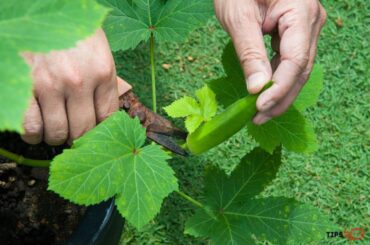The eye-catching evergreen foliage and also the easy-care characteristics have made ferns ideal houseplants. Anyway, Can I keep ferns in the bedroom? Will there be any adverse effects associated with them?
Through this article, you will learn all the important facts that you should know about growing ferns indoors. So, we would like to recommend you to read this article, especially if you’re interested in growing ferns in your room.

Introducing plants into your living space would be a great way to add an elegant look and improve your mental well-being as well. Because some houseplants are not just showy.
They perform certain important functions beyond their aesthetic appearance. Ferns, as indoor houseplants, play a great role.
Can I Keep Ferns In The Bedroom?
In most cases, yes you can keep ferns in your bedroom unless you have plant allergies. Ferns are gorgeous plants to have in your room. They can make your room inviting, calm and hassle-free.
Obviously, these beauties will create green feelings in your mind in order to expel stress and anxiety away. So, you can have a peaceful sleep in an atmosphere where you recover at the end of a tiring day.
Interestingly, ferns absorb certain hazardous chemicals in the air including but not limited to formaldehyde, toluene, and xylene. Thus, ferns make your room safer to breathe in.
Some people hesitate to keep plants in their bedrooms thinking that they will be suffocated by carbon dioxide gas released by the plants during the night times. Actually, having a few ferns in your room won’t increase carbon dioxide to a harmful level at all.
There are several fern varieties that are ideal to keep in your bedroom such as;
- Cotton candy Boston fern (Nephrolepis exaltata smithii)
- Asparagus fern (Asparagus densiflorus)
- Austral gem bird’s nest fern (Asplenium nidus)
- Maidenhair fern (Adiantum aethiopicum)
- Rabbit’s foot fern (Davallia fejeensis)
- Boston fern(Nephrolepis exaltata)
Are fern spores bad?
Literally, ferns are not poisonous plants. However, they might cause some problems for those who suffer from plant allergies.
Most ferns produce spores rather than producing seeds. The propagation of the majority of ferns happens via these spores. The spores appear on the bottom side of the leaves. The tiny spores have gathered to make a small bunch, called sorus. What you see as small brown-colored patches on the bottom side of the leaves are the sori.
Allergies can be caused by inhaling these tiny spores. Once the spores are detached from the plant, they can be circulated with the airflow. If these spores are inhaled, it may aggravate allergies. Other than that, the fern sap can cause irritations on the skin.
If you are highly sensitive to airborne spores like materials you should be mindful not to keep spore-forming ferns like Boston fern in your room or you can keep them outdoors. However, fern lovers with plant allergies can still keep some fern varieties such as austral bird’s nest fern and asparagus fern in their room since they don’t produce spores.
Is Boston fern dangerous?
According to the ASPCA, Boston fern is considered non-toxic to humans and animals. Touching, contacting the sap, or ingestion of leaves of Boston fern doesn’t do any harm. But as mentioned earlier, since this fern reproduces via spores, there can be consequences if those spores are inhaled by people with plant allergies.
Children are curious in nature. Sometimes they might allude to plants to touch or taste. Further, the floppy fronds of ferns make cats invited to play with. If you notice your pet spitting up fern leaves, it is because your pet has eaten leaves too much. Just spray some diluted vinegar solution onto the plant to discourage eating the plant by your pet.
If the plant is poisonous, the effects will be uncomfortable. At any rate, if you have Boston ferns in your home, won’t do any harm to your children or pets.

Are indoor ferns hard to keep alive?
The majority of indoor ferns are not hard to grow. If you care for them properly, they will live for many years, sometimes even decades. When compared to plants like orchids you will find ferns are much easier to grow.
As they are low-maintenance plants, you can make them satisfied with a few basic inputs. As long as you provide them with the right levels of water, nutrients, and sunlight, ferns can thrive indoors.
Usually, tropical ferns that often grow indoors are well adapted to low light and high humidity levels. Ferns with thick and leathery leaves are ideal as indoor plants whilst thin and feathery foliage species are good to grow outdoors.
Did you know ferns are one of the oldest plants on the planet Earth? They have been thriving for so many years under different environmental conditions ranging from cold to tropical.
Most importantly, if you want to see your ferns alive in all glory, choosing the right fern type for your climate zone is equally important as addressing the basic requirements of your ferns in terms of humidity, light, moisture, and feed.
For example, Asparagus fern and Austral gem bird’s nest fern are suitable for zone 9-11, and American maidenhair fern is suitable for zone 3-8. If you’re not certain, do a bit of research to find out the suitable varieties before buying a fern.
You will learn more about the ferns’ needs for water, fertilizer, and light in the following sections of this article.
How often should indoor ferns be watered?
Setting an exact time schedule to water ferns is quite hard as the moisture requirement of ferns differs with the environmental conditions. So, rather than sticking to a fixed time schedule, fulfilling the timely water requirement of the ferns is the best way to go.
Ferns love the soil to be moist but not soggy. So make sure the soil is damp consistently to keep your ferns hydrated. Before watering feel the moisture level in the soil about one inch deep with your finger.
If you feel the soil is wet, better to delay watering for another day. But if the soil is dry and crumbly, you should not hesitate to water the ferns. Do not wait till the soil is completely dry to water. You should never let the soil dry out completely unless you want to see your fern turn brown and die.
There are a few exceptions like holly ferns, rabbit’s foot fern and brake fern, western sword fern that tolerate dry soil between waterings.
Water ferns with room-temperature water. Sit the pot under running water until water drains from the bottom of the pot or else you can soak the pot in water for a few minutes and allow it to drain out excess water before spotting it in your room.
Selecting the right pot for ferns is crucial. The pot should facilitate good drainage. Using a pot with a hole at the bottom will do its job.
A word of caution: if you let your ferns sit in water for a long time by overwatering them, rotting the roots would be unavoidable. If this happens it may not take much time to kill your lovely plants.
When should you fertilize indoor ferns?
Ferns are not flowering plants. They grow for their beautiful foliage. Thus, you can feed your indoor ferns with a slow-release balanced fertilizer like 20-20-20 when they actively grow.
Generally, new fronds are highly emerging in the spring to fall. Thus, the provision of a nutrient-rich diet for ferns is essential during this time. Use half of the recommended rate of fertilizer for indoor ferns.
Ferns that grow in the wild gain nutrients consistently from natural decaying matter in their surroundings. But once we grow them indoors we need to intentionally provide nutrients steadily to boost the healthy growth of ferns.
Ferns love to have plenty of organic matter in their soil. If you love to treat your ferns with homemade natural fertilizer rather than using chemicals then the use of compost is the best option for you. Compost is a great feed for ferns as it contains ample organic matter and other minerals that are vital for plant growth and development. Simply, mix a few handfuls of compost with the soil of your fern.
If you notice that the fronds of your ferns turn yellow or if it produces smaller or misshapen leaves than usual, it probably indicates the fern lacks sufficient nutrients. On the other hand, if you over apply fertilizers, the foliage will be burnt.

Should you prune indoor ferns?
Intensive pruning for indoor ferns is not necessary at all. But if you want to see the best lush green display of ferns, a light pruning will be helpful to you.
You can remove discolored, old, dead, or any kind of unwanted fronds from your ferns. As they age, the leaves switch color to brown. This might ruin the nice green appearance of ferns. Typically, pruning in the late winter or early spring is ideal. Further, you can prune ferns during repotting.
Pruning will help not only to scale up the appearance but also for saving nutrients that can be used for new plant growth. Because though the fronds are old or misshapen they will still consume some amount of energy and nutrients. Trimming off these unnecessary fronds will redirect this energy to newly popping up fronds.
Should you bottom water ferns?
It is a good idea to bottom water ferns. Ferns need evenly moist soil throughout the day. If the soil is dry even for a few hours, the ferns will start to give a dull texture. When you bottom water ferns, the soil will suck up water until it gets saturated.
Even while the water droplets that fell on the ferns’ leaves during overhead watering evaporate with the contact of sunlight, they may still result in sunburn patches on the leaves, which will make your ferns look less attractive. But if you do bottom watering for ferns, you can prevent the occurrence of sunburn spots on the foliage.
Can ferns live indoors without sunlight?
Literally, indoor ferns do not require bright light. However, ferns won’t thrive with no sunlight at all.
In rainforests, ferns grow under canopies of huge trees. So, they received filtered sunlight (indirect light) to grow happily. Therefore, it is important to provide medium light when ferns are grown indoors. Note that direct sunlight will hurt ferns by scorching the foliage. Sensitive ferns like maiden hair fern will be burnt by the strong sun.
Place ferns near an east-facing or north-facing window so you can ensure ferns get gentle skylight. Avoid south-facing and west-facing windows to spot your ferns as the plants may expose to harsh sunlight through those windows.
If possible, it will be better if you can use a sheer curtain to filter out the light that reaches your ferns. Or else just keep the plants a few steps away from the sunny area near the window.
Why is my indoor fern turning brown?
Ferns can turn brown due to several reasons. Dry soil, the arid ambient environment, too strong sun, too much airflow, overwatering, and higher temperatures cause turning fern leaves brown.
If you underwater or overwater your ferns, you will experience the browning of fronds. Dry soil leads ferns to become dehydrated. Further, root rot resulting from too much water makes the root unable to absorb water. When the ferns cannot get enough water, the plants will begin to dry.
In addition, when the environment of the plant surrounding is dry, or in other words, if the humidity level is too low, the plant will lose much water via transpiration. Usually, indoor ferns can thrive in low humidity levels but they prefer the ambient humidity to be at least 30%. The condition can be exacerbated if the fern is not having access to absorb water consistently. You can simply correct the humidity level by misting the ferns.
Ferns prefer shades to grow. They cannot tolerate the direct sun as it burns the fronds of ferns. Keep your indoor plants away from sunny windows unless you’ve not used curtains to filter light.
Strong winds or air conditioning units remove much water from the plant. In addition, indoor ferns prefer temperatures between 65-75oF (18-24 oC) daytime and about 50 oF (10 oC) at night. Extreme temperature fluctuations can force ferns to turn brown.
Where do ferns grow best?
Ferns perform best in an environment where they acquire the right conditions. Well, the requirements for healthy growth depend on the fern species. Because some ferns enjoy bright light whilst most ferns crave shady areas to grow. Moreover, some ferns don’t mind soil being dry for a while but others need moist soil constantly.
However, generally, for most indoor ferns, providing a damp and shady area is the way to go. Further, try to maintain a mild temperature but not above 24 oC around your ferns.
If your house is air-conditioned, misting or keeping the fern pot on a humidity tray will help you to achieve the desired high humidity levels.
Make sure that ferns get enough moisture and fertilizers for optimum growth. You have already learned about the water and fertilizer needs of ferns.

Related questions
Do ferns do well in bathrooms?
Most ferns are moisture-loving plants. They enjoy low light, mild temperatures, and high dampness in the bathroom environment. Fern species that are most suitable for keeping in bathrooms are; Boston fern, Maidenhair fern, Button fern, and Bird’s nest fern.
Do ferns do well in dark rooms?
Most ferns grow well in low light. But this doesn’t mean that you should restrict the sunlight for ferns completely. That said, ferns are good for rooms that don’t have plenty of skylights. Wart fern, Asparagus fern, and maidenhair fern are some fern varieties that thrive in low light conditions.
To wrap up
The main question we had was “Can I Keep Ferns In The Bedroom?” Thanks to the lush foliage, ferns add a stunning green texture to the home environment. Most indoor ferns prefer indirect light, mild temperatures, high humidity, and moist soil with plenty of organic matter will make your ferns happy and healthy. Having a well-nourished fern will definitely make your room pleasant and fresh.
Read Next : What To Feed Ferns In Pots? (Correct Answer)




